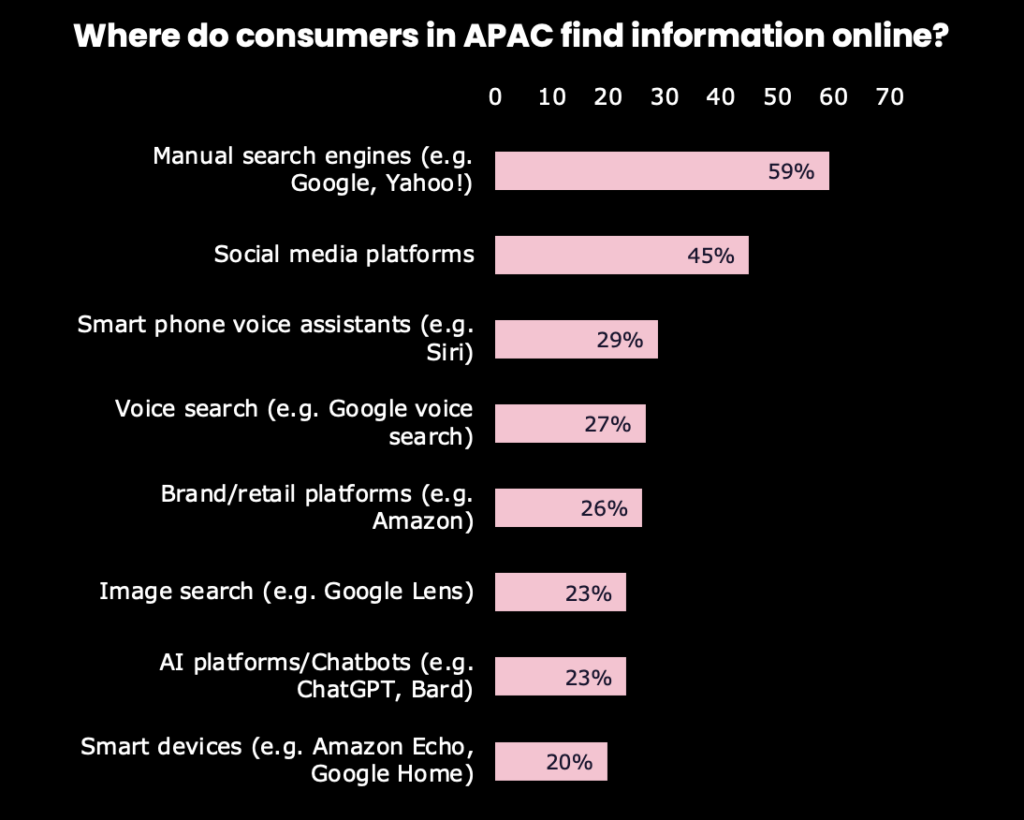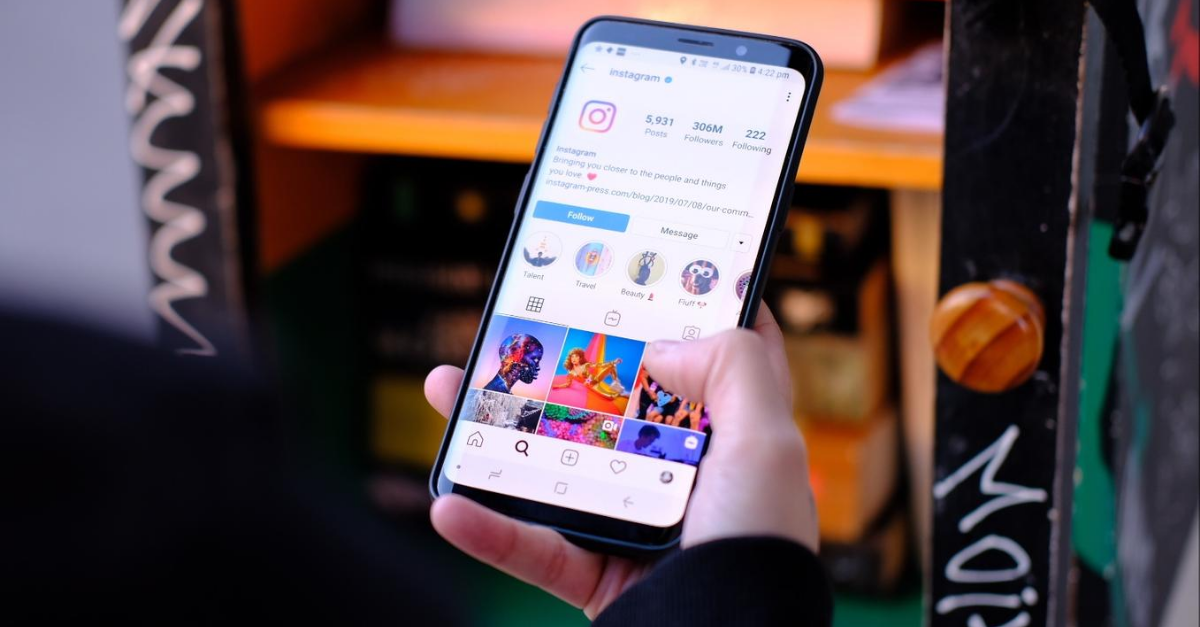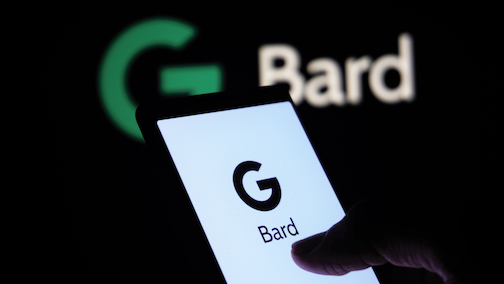Where do you seek online information? Search engines have become so integral to this process that “Google” functions as both a verb and a brand. The era when consumers relied solely on advertising or word of mouth for inspiration now feels like a bygone age, as the digital landscape rapidly transforms, introducing new search habits and platforms such as social media, voice, image search, and the emerging player, AI.

Understanding consumer search behaviour is crucial for businesses aiming to tailor digital strategies effectively. Using insights from our data partner GWI, we delve into the search trends by different consumer segments, in order to help brands enhance online visibility towards the right target audience.

#1 Retail Search
Millennials are the key group searching for products on e-commerce sites
Being the pioneers in fully embracing e-commerce, millennials (19.7%) in APAC stand out as the primary group actively seeking new brands and products on online retail websites, followed by Gen X (18.7%) and Gen Z (18%).
Their purchase decisions are notably influenced by factors such as a seamless shopping experience, mobile optimisation, and consumer reviews. Additionally, younger consumers value visual representations of product showcases and reviews, along with personalised recommendations.
What’s next?
To engage tech-savvy and open-minded young shoppers, brands should innovate by infusing freshness into their approach. Consider Temu, often hailed as the “Chinese Amazon”, the platform has essentially gamified the shopping process. Millennials, 31% more likely than the average Temu user, appreciate personalised recommendations. While less common among older users, they are still attracted to the platform for its competitive prices and extensive product selection.

#2 Social search
Shortening consumers’ purchase journey
Social media has evolved into a primary information source for potential buyers, ranking in the top 5 reasons for its use, particularly for finding inspiration for products. In APAC, Gen Z and millennials are 28% more likely than the older generation to seek brands and products on these platforms, which have transformed into spaces for discovering, researching, and purchasing products without navigating away.
TikTok and Instagram dominate as the most popular social media platforms in APAC, chosen for product research due to users’ desire for inspirational content, leveraging the visual nature of these platforms.
What’s next?
Integrated e-commerce functionality facilitates a swift transition from search to purchase for potential buyers. Simultaneously, given the enduring popularity of Facebook’s Marketplace among older social shoppers, it underscores the importance for brands to establish a presence across diverse platforms for broader consumer reach.
Recognising the younger generation’s impulsive purchasing behaviour, deploying a livestream strategy to showcase products with a direct purchase link within the same window can be highly effective in driving sales. This approach has proven successful in China, particularly on social platforms like Douyin.
#3 Short-form video search
Gen Z are the key consumers of short-form videos
As social media increasingly embraces visuals, consumer product search behavior has evolved, particularly within the young generation. One in three Gen Z individuals in APAC discovers products and brands through Instagram and TikTok, while 42% of Gen Y relies on TikTok.
The surge in short-form video content, particularly on vertical video apps favored by Gen Z, has become a go-to source for easily digestible “how-to” tips and tricks, facilitating surface-level discovery. Gen Z’s inclination toward short-form videos is evident, with 35% watching YouTube shorts and 27% viewing Instagram Reels monthly, making them nearly three times more likely than baby boomers. TikTok’s influence in expediting the video search process, coupled with the introduction of TikTok shop , has further streamlined the purchasing experience.
What’s next?
Elevate brand awareness among Gen Z and Millennials by creating compelling video content on social platforms. High-quality videos not only engage followers but also extend exposure to a broader audience when tailored to their interests.
Moreover, with 84% of consumers deciding to make a purchase based on short-form videos, brands can capitalise on the TikTok shop feature, harnessing the influential impact of short-form videos to efficiently drive conversions.
#4 Image Search
Online fashion purchase is becoming more visually engaging
Gen Z stands out as the generation most inclined to explore alternative search methods, with 30% in APAC favouring image search, surpassing the average by 28%. Unlike manual searches that yield a list of blue links, image search offers a visually engaging experience, proving particularly beneficial for individuals immersed in visual mediums. Those utilising image recognition tools display a heightened interest in modern art, photography, and fashion compared to the average consumer.
What’s next?
Fashion purchase decisions are heavily influenced by similar products seen by users, prompting many brands to incorporate image search features. For instance, ASOS’s Style Match, a visual search tool offered by ASOS, allows users to effortlessly find clothing and accessories by uploading or taking a picture, streamlining the product discovery and shopping experience.
For fashion enthusiasts, augmented reality-enhanced try-ons have revolutionised image searches, allowing users to virtually try on products like clothing, eyewear, or cosmetics using their device’s camera. This innovation reduces uncertainty in online shopping, boosting overall user confidence.

#5 AI
Search has a ‘personal’ touch
Traditional manual search has long struggled with understanding human speech, but now, Chatbots like ChatGPT provide a personalised one-on-one browsing experience, with nearly two-thirds of users treating it like a real person.
What’s next?
It’s no surprise competitors like Google and Bing swiftly integrated AI into their search experiences, a trend X has also followed. While each offers a unique vibe, the pivotal moment lies in providing real-time information.
Key Takeaways
Curious about the trends impacting your brand? Watch our Webcast: Lifting Brand Awareness with Data-Driven Strategy, or get in touch with our data and insights specialists here.




